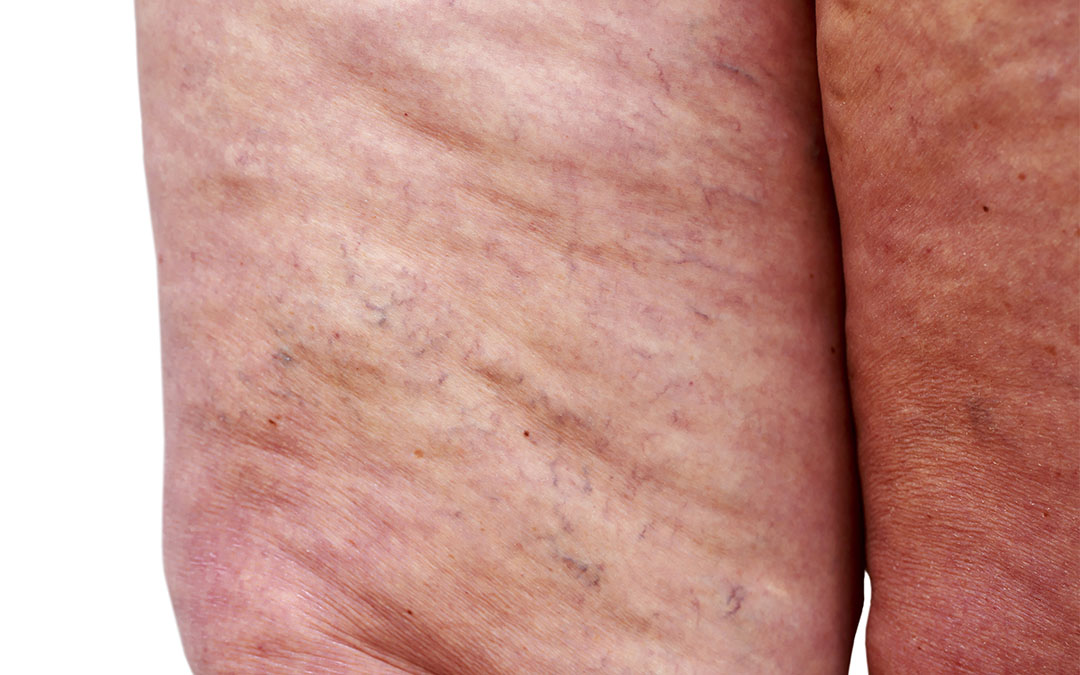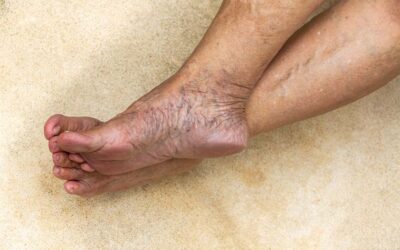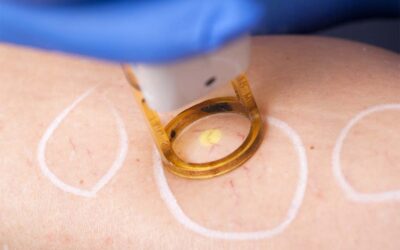Reticular veins are the visible veins below your skin that appear blue-purple in colour, but they don’t bulge out as varicose veins do. Reticular veins are smaller than varicose veins but often appear together with them, the feeder vein smaller spider veins, causing pain and symptoms just like varicose veins do. They may also appear without symptoms.
Reticular veins are often present in normal healthy legs. “Reticular” comes from the word “reticulate” meaning “network-like”. Reticular veins appear like a complex network of surface veins. However, when the valves inside deeper truncal or perforator veins become incompetent, this allows blood flow to leak into the reticular veins in an abnormal fashion. The blood collects and pools in the connected network of surface veins, causing them to enlarge and become noticeable on the skin. This blood can then push from the reticular veins into smaller spider veins, resulting in a very characteristic presentation like the veins fanning out on a leaf. This may cause symptoms like pain, itching, and throbbing.
Where are reticular veins located in relation to the skin surface?
Reticular veins are often known as subdermal veins because they are located just below the dermis (ie: the layer of skin between the epidermis and the subcutaneous layer). Reticular veins are often visible but, in some cases, may hide beneath the skin, making them difficult to detect during the examination. This is where an ultrasound examination will reveal the reticular veins and help with treatment.
Do reticular veins go away on their own?
No. Without medical treatment, reticular veins will not heal with time. The tissue they are composed of is of a kind that does not heal itself.
(Sometimes women notice varicose and reticular veins become worse during pregnancy and may appear to improve afterward. However, the damaged sections of the vein are still present and will likely continue to cause symptoms like heaviness, throbbing, itching, etc. Following pregnancy, the pressure placed on the veins by the baby, blood volume, and the uterus is reduced again, taking the burden off the veins, but the damage is still present and will not heal alone.)
Are reticular veins dangerous?
Reticular veins may present for several reasons including a family history of vein conditions, occupations that require prolonged standing or sitting, pregnancy or hormonal changes, aging, and obesity. When incompetent leg veins are not medically treated, they may develop into more severe symptoms, especially in the case of hereditary causes.
If chronic severe varicose veins develop, you may experience symptoms such as leg swelling, venous eczema (itchy, flaky, and angry skin), the skin may become discoloured near the problem veins, or thicker and harder at the ankles, and open sores may develop.
When even these more severe signs are not acted upon, infections and even blood clots can occur.
Treating reticular veins
Treating reticular veins can be a complex procedure. In some clinics, doctors only treat the visible veins with direct vision sclerotherapy (also known as surface sclerotherapy or microsclerotherapy). Focusing only on what is visible is a mistake. Reticular veins can often hide underneath the skin, so it is important that duplex ultrasound is used to treat these veins along with the visible surface veins. Ultrasound will also help detect any underlying perforators that may potentially feed these reticular veins. When this is the case, medical-grade glue may be used to seal off the perforator if ultrasound guided sclerotherapy proves ineffective.
Dr Paraskevas treats reticular vein networks with ultrasound guided sclerotherapy (UGS) and direct vision sclerotherapy (DVS). Reticular veins frequently present alongside varicose veins so other vein treatment techniques may be used in tandem with UGS and DVS.
Treatment options like endovenous laser ablation, vein glue, and radiofrequency ablation all use slightly different methods to seal off larger, internal feeding veins.
Key Takeaways
- Reticular veins are incompetent veins that are smaller than varicose veins (about 3mm in diameter), but larger than spider veins.
- They do not go away on their own or heal over time without medical intervention.
- Reticular veins can be a concern when left untreated if they are allowed to develop alongside varicose veins into severe/chronic venous disease. This involves increasingly debilitating symptoms of pain, skin rashes, and open sores which can lead to infection and even blood clots.
- Dr Paraskevas treats reticular veins with ultrasound guided sclerotherapy, following a comprehensive examination and diagnosis. If varicose veins and other problem veins are present, he may use this in conjunction with other vein treatments to achieve the best outcome for the patient.






